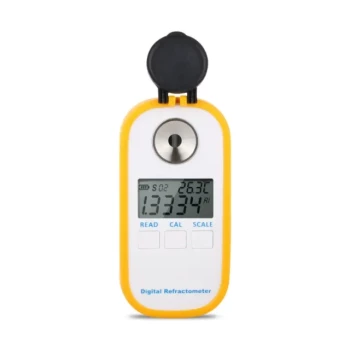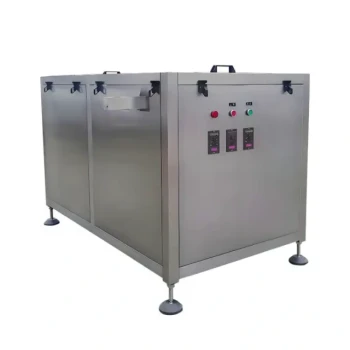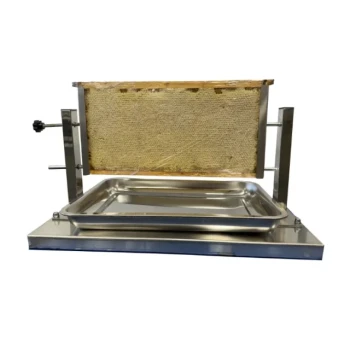For a hobbyist beekeeper, a honey refractometer is not strictly required, but it is the single most reliable tool for ensuring your harvested honey will not spoil. While experienced beekeepers have long used visual cues, a refractometer replaces guesswork with a precise measurement of water content, which is the critical factor that determines if your honey will ferment in the jar.
The core issue isn't whether you need a refractometer, but whether you are willing to risk your honey harvest on estimation. This simple tool provides the data-driven certainty that your honey is ready for long-term storage, protecting it from fermentation and spoilage.
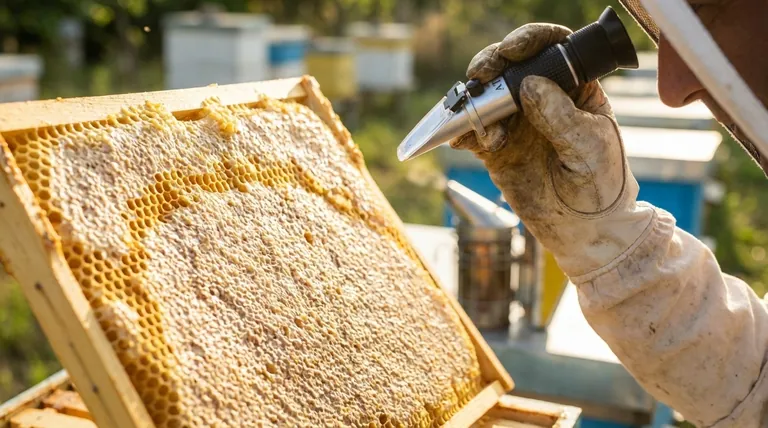
Why Moisture Content Is the Critical Factor
Honey's longevity is entirely dependent on its water content. A refractometer is simply a tool to measure this one crucial variable.
The "Safe Zone" for Honey
For honey to be stable and resist spoilage, its water content must be below approximately 18.6%. Above this threshold, naturally occurring osmophilic yeasts can become active.
Honey that falls within this safe zone will remain preserved almost indefinitely. Its low water content and high sugar concentration create an environment where microorganisms cannot survive.
The Risk of Fermentation
If honey is harvested with a water content that is too high, the dormant yeasts can begin to multiply. This process of fermentation breaks down the sugars into alcohol and carbon dioxide.
Fermented honey will taste sour, smell unpleasant, and may appear fizzy or foamy in the jar. It is spoiled and no longer suitable for consumption. A refractometer is your best defense against this outcome.
The Impact of Low Moisture
Conversely, honey with very low water content (e.g., below 16%) is more prone to crystallization. While some consumers dislike the texture, crystallization is a natural process that does not indicate spoilage.
The honey is still perfectly safe to eat and can be returned to a liquid state by gently warming the jar in water.
Moving Beyond Traditional Harvest Cues
For generations, beekeepers relied on "rules of thumb" to decide when to harvest. A refractometer provides a scientific upgrade to these traditional, less precise methods.
The "Capped Honey" Rule
The most common guideline is to harvest frames that are at least 80% "capped," meaning the bees have sealed the honeycomb cells with a layer of white wax. This capping is a strong indicator that the bees themselves consider the honey cured and ready for storage.
When the Cues Are Unreliable
However, bees do not always cap honey, even when its moisture content is safe. This can happen during a strong nectar flow when they are focused on collecting, or if they have a limited wax supply.
In these situations, you could be leaving perfectly good honey in the hive or, conversely, harvesting uncapped honey that is not yet ready. A refractometer removes this ambiguity.
The "Shake Test" Limitation
Another traditional method is the "shake test," where a beekeeper holds a frame horizontally and gives it a sharp shake. If no honey drips out, it is often considered ready.
While better than nothing, this is a highly imprecise test. A refractometer offers a definitive measurement instead of an estimation.
Understanding the Trade-offs
A refractometer is an investment, and it's important to weigh its cost against the value it provides for your specific operation.
Cost vs. Risk
An analog honey refractometer is a relatively inexpensive tool. Its cost should be weighed against the value of your honey harvest and the time and effort you've invested.
Losing an entire batch of honey to fermentation because of a high water content can be far more costly than the one-time purchase of a refractometer.
Hobbyist vs. Commercial Needs
For commercial apiaries, a refractometer is non-negotiable. They must meet legal and industry standards for moisture content to sell their product.
For the hobbyist, the tool is about personal quality control and peace of mind. It allows you to produce the highest quality honey possible and confidently share or gift it without worrying about spoilage.
Analog vs. Digital Models
Most hobbyists will be perfectly served by a simple analog refractometer. These devices require you to place a drop of honey on a prism, close the cover, and look through an eyepiece toward a light source to read the scale.
Digital refractometers are more expensive but easier to use. They have a digital display that shows the reading automatically, eliminating any potential for misinterpretation.
Making the Right Choice for Your Goal
Your decision to buy a refractometer should align with your beekeeping philosophy and objectives.
- If your primary focus is maximum certainty and quality: A refractometer is a wise and necessary investment to guarantee every jar of your honey is stable and preserved.
- If your primary focus is sticking to a tight budget: You can proceed without one by strictly following the "80% capped honey" rule, but you must accept the small but real risk of losing some honey to fermentation.
- If you plan to sell or gift your honey widely: You should absolutely use a refractometer to ensure a safe, professional-grade product and protect your reputation.
Ultimately, a refractometer empowers you to harvest with data-driven confidence, turning your hard work into perfectly preserved honey.
Summary Table:
| Key Consideration | Why It Matters for Hobbyists |
|---|---|
| Safe Moisture Level | Honey is stable and won't ferment if water content is below 18.6%. |
| Risk of Fermentation | High water content (>18.6%) allows yeast to grow, spoiling the honey. |
| Beyond Traditional Cues | Replaces guesswork from the 'capped honey' rule or 'shake test' with precise data. |
| Cost vs. Value | A small investment protects the time, effort, and value of your entire harvest. |
Harvest with Confidence Using Professional-Grade Equipment
Don't leave the quality of your honey to chance. For hobbyists and commercial apiaries alike, using the right tools is essential for success. HONESTBEE supplies durable, reliable beekeeping equipment—including honey refractometers—to beekeepers and distributors through our wholesale operations.
We help you protect your harvest and produce honey you can be proud to share. Contact HONESTBEE today to discuss your equipment needs and ensure your honey is perfectly preserved.
Visual Guide
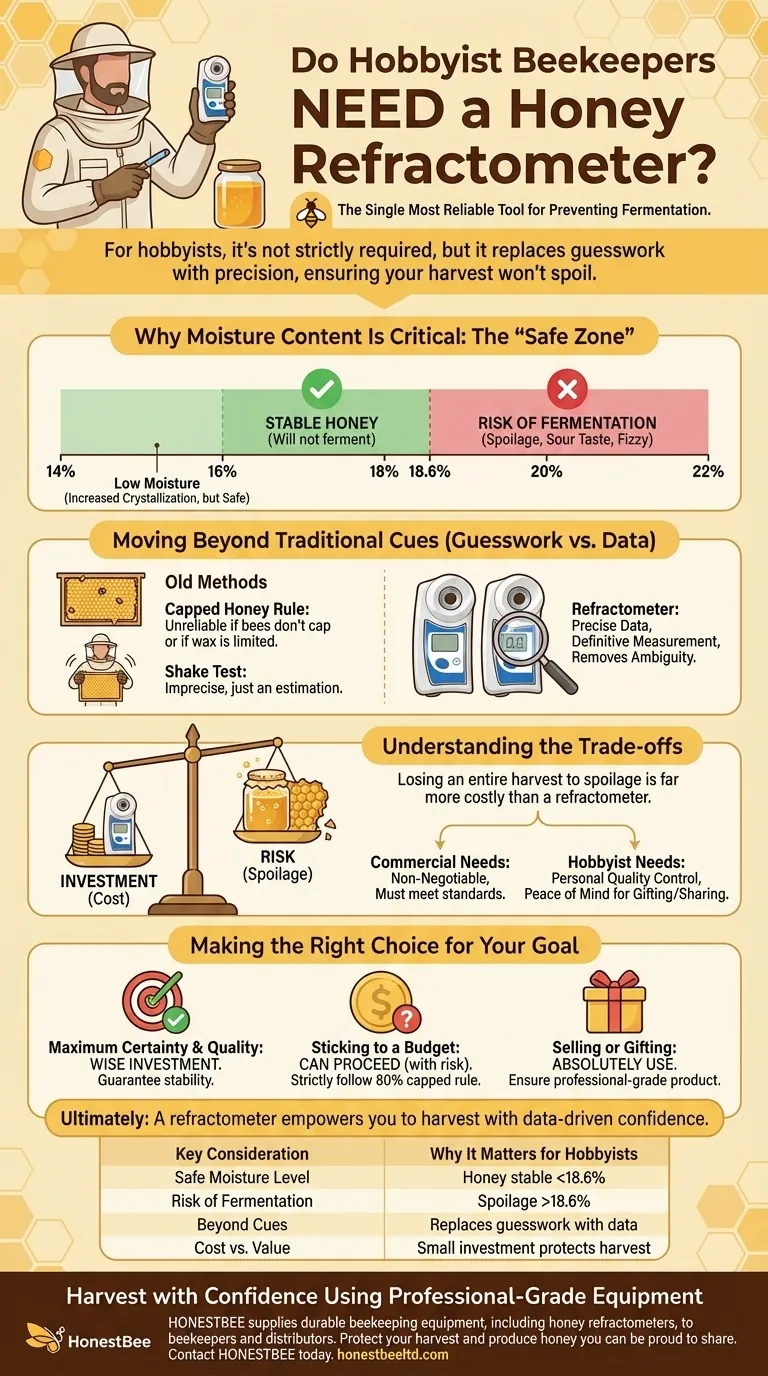
Related Products
- Precision Honey Refractometer Instrument for Quality Assessment
- Digital Honey Refractometer for Precision Measurement of Optimal Honey Quality
- Professional Thermostatic Conical Honey Melter
- Honey Concentrating Vacuum Heating Thickening Machine Dehumidifier for Honey
- 8-Frame Electric Self-Reversing Honey Extractor Spinner for Commercial Honey Extraction Equipment
People Also Ask
- What is a honey refractometer? The Essential Tool for Perfect Honey Quality
- Why is a honey refractometer important for beekeepers? Ensure Quality and Prevent Fermentation
- What are the key steps to using a honey refractometer? Ensure Honey Quality & Prevent Fermentation
- Why is a honey refractometer considered essential for commercial beekeepers? Ensure Honey Quality and Profitability
- Why is a honey refractometer essential for honey harvesting? Protect Your Harvest from Spoilage

